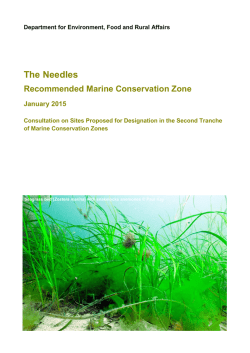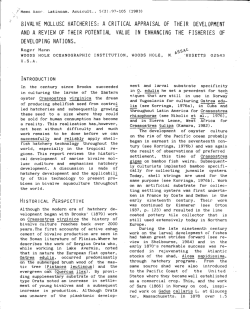
Control of Predators on Cultured Shellfish
NRAC Publication No. 00-007 Northeastern Regional Aquaculture Center University of Massachusetts Dartmouth North Dartmouth Massachusetts 20747 Control of Predators on Cultured Shellfish: Exclusion Strategies Dale F. Leavitt, Aquaculture Specialist, SouthEastern Massachusetts Aquaculture Center William P. Burt, Marine Specialist, SouthEastern Massachusetts Aquaculture Center Introduction Predation is one of the most significant means by which shellfish farmers lose their crop during the field nursery and grow-out stages of production. All field culture technologies are susceptible to predation if not properly designed and maintained. Under some circumstances, farmers have reported up to 100% mortality resulting from the unintentional introduction of predators into the culture system. Flimlin and Beal (1993) have previously discussed the principal predators on cultured shellfish (Flimlin, G.F. and B.F. Beat. 1993. Major Predators of Cultured Shellfish. NRAC Bulletin No. 180- 1993. Northeast Regional Aquaculture Center, Dartmouth, MA. 6 pgs.) In addition, the authors provided general descriptions of methods to control each type of predator. The objectives of this Technical Bulletin are to elaborate on one specific type of technology, namely exclusion, to minimize the impact of shellfish predators on shellfish farms and to report on one apparatus that has recently been developed that shows promise as a means to exclude predators, primarily large gastropod whelks of the genera Busycon and Busycotypus. Mobile predators, such as crabs and snails, generally rely on chemical cues to lead them to high concentrations of prey. In response to a chemical scent they follow the track of the cue until they encounter the desired food item. The primary means that a shellfish farmer has to reduce losses due to predators converging into the active growing area is to either remove the predator from the area of the farm or exclude it from moving into the vicinity of the shellfish. Predator removal, either through trapping or other means to eradicate the predator, is a strategy that generates significant debate in both scientific and resource management circles. Figure I : A common predator of farmed oysters and clams in the northeastern U.S. is the green crab, Carcinus maenas. Reprinted with permission from: Weiss, H.M. 1995. Marin~ Animals of Sourhem New England and N~w York. While some argue that trapping and removal reduces the density of predators within a specific area, others suggest that by reducing the local density of a predator, the manager is opening up areas for recruitment of new individual predators due to locally reduced population densities. The scientific research community is currently studying these questions to try to evaluate the efficacy of predator removal programs. The most reliable option available to shellfish farmers is to provide a barrier to prevent specific predators fro m gairting access to their prey, also known as the crop. This can be in the form of a physical barrier, such as a cage surrounding the shellfish or a fence enclosing the growing area, or a spatial barrier, such as growing shellfish in suspended culture systems to prevent benthic, non-swimming predators from gairting access to the culture system. As suggested above, barrier systems can be effective against some types of predators and less effective against others. For example, straight vertical fencing was tested exclusively in the early 1950's as a means to exclude the booming green crab (Carcinus maenas) populations from devastating soft shell clam (Mya arenaria) resources in Maine. The fences were 18" wire mesh strung vertically along stakes placed in the tidal flat. Although the fencing prevented crabs from preying on clams, the work required to maintain the fencing and the recruitment of juvenile crabs into the enclosed culture area, where they subsequently grew to a size that was able to prey on soft shell clams, d iminished the shellfish manager's enthusiasm for vertical fencing. A more effective means to exclude surface crawling predators, i.e . crabs, is netting or screening placed over the planting area. A net with a mesh size smaller than the size of the bivalves planted under it not only excludes predators but it also prevents the seed clams or oysters from washing out of the system if exposed to any wave or high current action. The placement of the netting is dependent on the species being cultured. For oysters, or other epifaunal shellfish, the netting can be laid down on the sediment and the seed oysters placed on top of one-half of the netted area. The other half of the net is then folded over the top of the oyster bed and the edges are sealed down by burial and/or by wire staples. The oyster "envelopes" are then in place and will exclude those predators larger than the mesh size of the net. For hard clams, or o ther in faunal shellfish, the bed is turned over by raking or hydraulic means and any predators exposed are removed. The clams are seeded onto the bed and a single layer of netting is stretched over the planted clams. The edges can be tacked down either to boards buried on edge in the sediment, effectively forming a large box, or by burying the edge of the netting that has been previously attached to lead line or steel rebar along the perimeter. To exclude the majority Figure 2: Another common predator of farmed oysters and clams, south of Cape Cod, is the knobbed whelk, Busycon Carica. Reprinted wilh pemtission from: A Manual of Fislz Culture. U.S. Fish Commission Report for 1897. Control of Predators on Cultured Shellfish: Exclusion Strategies of burrowing predators (crabs and gastro pods) the sides of the net should be buried eight inches or more. In either case, maintenance is paramo unt to the successful exclusion of predators when using netting. The first concern is small predators that have recruited under the net and subsequently grow n to a size large enough to consume your shellfish. The other concern is to remove biofouling that can reduce water flow under the net and across the planted clams to the point where it can lead to impaired productivity and even mortality. Gastropod mollusks, primarily whelks of the genus Busycon and Busycotypus, can be significant predators on oysters and hard clams planted in subtidal areas. It has been demonstrated that the presence of the knobbed whelk (Busycon carica) can inhibit hard clam growth if in the vicinity of the clam bed even if it cannot directly prey on the population (Nakoaka, M. 1996. The predator decreases not only survivorship but also growth of the prey: a caging experiment with the clam Mercenaria mercenaria and the whelk Busycon carica. 24th Benthic Ecology Meeting). With the recent introduction of the Veined Rapa whelk (Rapana venosa) into the Mid-Atlantic area, another large gastropod predator is on the scene. A barrier system that has shown promise for excluding large gastropod predators on oyster and hard clam beds has recently been developed through fu nding provided by the Northeastern Regional Aquaculture Center. The Predator Exclusion Device (PED) was developed by Cotu it and Cape Cod Oyster Companies (Osterville, MA) under NRAC Grant# 95-6. The overall design was to construct a barrier around the shellfish planting area in the form of a fence-type system. The unique aspect to this system is that the barrier is a trough modeled after pyramidal "conch pots" and constructed from wire mesh that acts not only as a barricade but also as an elongated trap that holds the whelks within its structure until removed by the farmer. Whelks are a commercially exploited marine resource and, with the proper permits, the farmer can reduce local predator populations while producing a small income stream for the farm. Following testing of various designs of the PED system, the final product consisted of a truncated triangle shaped trough, when viewed in cross-section, with a base width of24" and two sides attached at 45° to the base and each I 0" long (Figure 3). The base is constructed of 12 gauge vinyl coated wire (l" mesh) on the bottom and 16 gauge vinyl coated wire (I" mesh) on the sides. The PED deployment simply corrals an area of bottom where one wishes to plant shellfis h. In an attempt to reach the shellfish, the whelks will climb the outside wall, fall into the space between the two walls but will be unable to make the turn up the inverted inside wall to continue to pursue the oyster scent traiL They become entrapped until removed. Stabilizers, or upright pieces of wire, are inserted into the PED every two feet to keep the sides in the correct position. NRAC Publication No. 00-007 2 of4 Maintenance of the PED requires observing the integrity of the barricade on a regular basis while removing whelks as they populate the interior of the PED. Damaged sections should be replaced and the channel cleared of debris and/or living material that may accumulate within the channel. This is to prevent the whelks from over running the barrier. During the PED development program, a large accumulation of limpet shells, herntit crabs, and several live whelks were observed in a corner section. One live whelk was observed climbing on top of another whelk, putting it very near the height of the top of the PED. It appeared to be in a position where it could have escaped the PED in this manner. Figure 3. A schematic of two sections of the PED where, in the linear section, the length is 4 feet, the base width is 24 inches, and each side is 10 inches. These also act as blocks that minimize the ability of a whelk to travel along the length of the PED. Although they were not designed to block the channel and are not I 00% effective in blocking movement, the stabilizers are effective in limiting movement within the PED as the openings on either s ide of the stiffener become clogged with limpet shells, hermit crabs, or a live whelk. The PED is built in four foot long modules that are deployed end to end to form a fence line but are not connected. This provides a "break away" type action if the structure is hit by a boat motor or fouled by ground taclde resulting in a small section of the barricade moving rather than distorting one whole side. Each section is anchored to the ground using three or more wire staples, similar to those used to anchor netting down. To use the PED, the planting area is cleared by dredging, hand raking and/or hand removal via swimming. The PED is installed and, before bottom planting, bags of oysters are placed within the enclosure to lure any concealed whelks to the area of the oyster as a final cleaning. Following the final cleaning, the area enclosed within the PED can be planted with small oysters (30mm val ve length). During PED development, several times whelks were found stuck and partially buried under the outside of the PED. It is thought that twenty-four inches is too long a linear distance for a whelk to travel under the substrate and still maintain the scent trail. Therefore they must surface at short intervals to maintain orientation to the scent. Whelks found stuck under the PED were never more than a few inches away from the outside perimeter and were entangled in the wire mesh while attempting to come to the surface. A summary of the costs for constructing a 100 by 100ft (10,000 ft2 ) PED are provided in Tables 1 and 2. Table I: Cost of materials and labor associated with PED construction. Vinyl coated wire mesh 16 gauge for sides, 12 gauge for bottom, 48" section $14.00 labor (assembly per linear foot) $ 0.50 stainless steel hog rings (per lb.) $ 5.50 stakes (each) $ 0.25 corner pieces (each) $25.09. labor (deployment per linear foot) $ 1.00 Table 2: The cost for purchasing, assembling, and deploying a 100' x 100' PED. Site preparation PED material Four comers 4 lbs SS hog rings Assembly labor Deployment labor $ 400 $1400 $ 100 $ 20 $ 200 $ 400 To study the efficacy of the PED, the NRAC investigators planted areas enclosed by a PED with oysters (fi ve per square foot) while maintai ning control areas planted to the same density but without the fencing. The oyster mortality attributable to whelks within six separate PED deployments at three locations, totaling 45,000 square feet of bottom and 8,800 oysters, averaged 7.7% with 826 whelks removed from the PED channel. This can be compared to a mean whelk induced oyster mortali ty of 96.4% (n= 1,400) in control deployments on unprotected bottom withi n the same oyster gro unds. Maintenance costs of a commercially deployed system would be minimal. The PED does not need to be cleared of whelks on a daily or even weekly basis. It is recommended that a regular schedule of observation to check for damage should Control of Predators on Cultured Shellfish: Exclusion Strategies NRAC Publication No. 00-007 Total $2520 3 of 4 be maintained. This can be done quickly in shallow sites by motoring along the perimeter of the PED by boat, identifying and repairing damaged sections as needed. Whelks could be cleared weekly or biweekly, at times of high whelk movement early in the season. Monthly removal of whelks would be adequate after the peak of activity in June. The $ 1000 per year budgeted for maintenance (parts and labor) should be more than adequate for a 10,000 square foot PED. Exclusion of predators on shellfish growing areas is an economic and effective means to minimize losses in an environmentally responsible manner. Many strategies are available to exclude predators. The predator exclusion device developed by Cotuit and Cape Cod Oyster Companies (funded by NRAC) provides one option to effectively control for predation by large gastropods. Acknowledgem ents: The SouthEastern Massachusetts Aquaculture Center is a collaborative effort between Cape Cod Cooperative Extension/Barnstable County, UMass Cooperative Extension, the Sea Grant Program at Woods Hole Oceanographic Institution, and the Commonwealth of Massachusetts. This material is based upon work supported by Cooperative State Research, Education, and Extension Service (CSREES), U.S. Department of Agriculture, under Agreement No.'s 94-38500-0044 and 95-38500-1423, awarded to the Northeastern Regional Aquaculture Center at the University of Massachusetts Dartmouth. Woods Hole 61 iiiliiXlliiliiliiNSiliiliiiO N Any opinions, findings, conclusions, or recommendations expressed in this publication are those of the authors and do not necessarily reflect the views of the U.S . Department of Agriculture, the Northeastern Regional Aquaculture Center, or the University of Massachusetts. Control of Predators on Cultured Shellfish: Exclusion Strategies NRAC Publication No. 00-007 4 of4
© Copyright 2025
!["Minho - Le Nord" [no. 1 "Old Land Portugal"] - Free](http://s2.esdocs.com/store/data/000459019_1-763f6c95acdaf20bb3a9381d878beb51-250x500.png)




